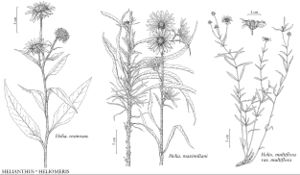Heliomeris
Proc. Acad. Nat. Sci. Philadelphia 4: 19. 1848.
| Taxon | Illustrator ⠉ | |
|---|---|---|
 | Helianthus resinosus Helianthus maximiliani Heliomeris multiflora var. multiflora | Marjorie C. Leggitt Marjorie C. Leggitt Marjorie C. Leggitt |
Annuals or perennials, (2–) 10–90 (–120+) cm. Stems erect, branched distally or ± throughout. Leaves mostly cauline; opposite or alternate; sessile or subsessile; blades usually 1 (–3) -nerved, elliptic, lance-linear, lanceolate, lanceovate, linear, ovate, rhombic, or rhombic-ovate, margins entire (often revolute), faces hispid or strigose to stigillose, sometimes glanddotted. Heads radiate, borne singly or in cymiform to paniculiform arrays. Involucres hemispheric or broader, 6–14 mm diam. Phyllaries persistent, 14–25 in ± 2–3 series (mostly lance-linear, herbaceous). Receptacles conic; paleate (paleae tan to brown, ovate to oblong-rectangular, conduplicate). Ray-florets 5–15, neuter; corollas yellow (laminae elliptic, oblong, obovate, oval, or ovate). Disc-florets 25–50+, bisexual, fertile; corollas yellow, tubes shorter than campanulate throats, lobes 5, triangular (style-branches relatively slender, apices acute). Cypselae (black, mottled, or gray-striate) weakly 4-angled, ± obpyramidal (glabrous); pappi 0. x = 8.
Distribution
sw United States, Mexico
Discussion
Species 5 (4 in the flora).
Heliomeris has often been submerged within Viguiera; herbaceous phyllaries, epappose cypselae, and distinctive chromosome base number provide morphologic and genetic features that correlate with molecular phylogenetic studies to suggest that it be recognized as distinct. A species from granite outcrops of the southeastern United States, Helianthus porteri, shows remarkable morphologic similarity to Heliomeris, but cytologic, crossing, and molecular phylogenetic studies have provided abundant evidence that it is properly placed in Helianthus. W. F. Yates and C. B. Heiser (1979) provided a useful summary of Heliomeris, and their treatment is followed here.
Selected References
Key
| 1 | Annuals; leaf margins conspicuously ciliate at least 3/4+ their lengths (hairs often 0.5+ mm) | Heliomeris hispida |
| 1 | Annuals or perennials; leaf margins ciliate to 1/4 their lengths (hairs to 0.5 mm) | > 2 |
| 2 | Annuals; leaf blades (at least proximal) ovate to rhombic-ovate, abaxial faces not gland-dotted; peduncle lengths 2–5 times leafy portions of stems | Heliomeris soliceps |
| 2 | Annuals or perennials; leaf blades (at least proximal) elliptic, lanceolate, lance-linear, lance-ovate, linear, or ovate, abaxial faces often gland-dotted; peduncle lengths 1/20–1/2 leafy portions of stems | > 3 |
| 3 | Perennials (caudices woody), proximal and midstem leaves relatively broad (lengths 2–8 times widths) | Heliomeris multiflora |
| 3 | Annuals (taprooted) or perennials (caudices woody), proximal and midstem leaves relatively narrow (lengths 6–30+ times widths) | > 4 |
| 4 | Annuals (taprooted), proximal and midstem leaves (40–)80–160 × 4–8(–12)mm | Heliomeris longifolia |
| 4 | Annuals (taprooted), proximal and midstem leaves 10–70(–85) × 1.5–5 mm, or perennials (caudices woody), proximal and midstem leaves 10–90 × 2–20 mm | > 5 |
| 5 | Annuals (taprooted, stem branching symmetric), proximal and midstem leaves 10–70(–85) × 1.5–5 mm, heads relatively small, involucres 6–9 diam | Heliomeris longifolia |
| 5 | Perennials (caudices woody, stem branching often asymmetric), proximal and midstem leaves 10–90 × 2–20 mm, heads relatively large, involucres 6–14 mm diam | Heliomeris multiflora |
"broader" is not a number.